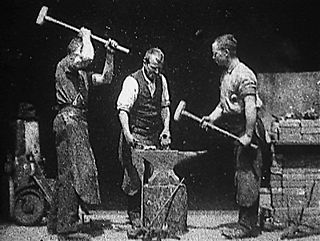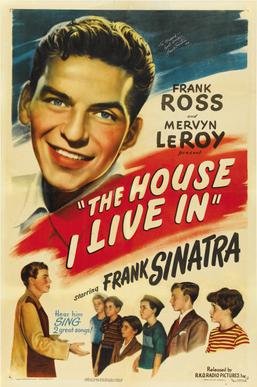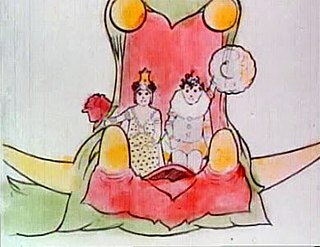Related Research Articles

Blacksmith Scene is an 1893 American short black-and-white silent film directed by William K.L. Dickson, the Scottish-French inventor who, while under the employ of Thomas Edison, developed one of the first fully functional motion picture cameras. It is historically significant as the first Kinetoscope film shown in public exhibition on May 9, 1893, and is the earliest known example of actors performing a role in a film. It was also the first U.S. motion picture film ever copyrighted that same year. 102 years later, in 1995, Blacksmithing Scene was selected for preservation in the United States National Film Registry by the Library of Congress as being "culturally, historically, or aesthetically significant". It is the second-oldest film included in the Registry, after Newark Athlete (1891).
Frank Film is a 1973 American animated short film by Frank Mouris. The film won an Academy Award for Best Animated Short Film and was inducted into the National Film Registry in 1996.

The House in the Middle is the title of two American documentary film shorts, respectively from 1953 and 1954, which showed the effects of a nuclear bomb test on a set of three small houses.

Jam Session is a 1942 short film, directed by Josef Berne, which shows Duke Ellington and his orchestra performing "C Jam Blues".

The Land Beyond the Sunset is a 1912 short, silent drama film which tells the story of a young boy, oppressed by his grandmother, who goes on an outing in the country with a social welfare group. It stars Martin Fuller, Mrs. William Bechtel, Walter Edwin and Bigelow Cooper. Produced by Edison Studios in collaboration with the Fresh Air Fund, the screenplay was written by Dorothy G. Shore and directed by Harold M. Shaw.

Let's All Go to the Lobby is an American animated musical advertisement that was produced in the mid-1950s for Filmack Studios. It was played in theaters before the beginning of the main film or before intermission, and features animated food items urging the audience to buy snacks sold in the theater lobby. It was directed by Dave Fleischer with lyrics by Jack Tillar.

The River is a 1938 short documentary film which shows the importance of the Mississippi River to the United States, and how farming and timber practices had caused topsoil to be swept down the river and into the Gulf of Mexico, leading to catastrophic floods and impoverishing farmers. It ends by briefly describing how the Tennessee Valley Authority project was beginning to reverse these problems.
Tulips Shall Grow is a 1942 American animated short film in the Puppetoons series, directed by George Pal and starring Rex Ingram and Victor Jory. It was released by Paramount Pictures and originally photographed in 3-strip Technicolor. It later became the black-and-white edition by National Telefilm Associates.
Fuji is a 1974 American animated short by Robert Breer.

The House I Live In is a ten-minute short film written by Albert Maltz, produced by Frank Ross and Mervyn LeRoy, and starring Frank Sinatra. Made to oppose anti-Semitism at the end of World War II, it received an Honorary Academy Award and a special Golden Globe Award in 1946.
Film Portrait (1972) is a full-length autobiographical film directed by, and about, the life of Minnesotan film-maker and artist, Jerome Hill.

Lady Helen's Escapade is a short American comedy film produced in 1909, directed by D. W. Griffith. It is about the escapades of Lady Helen working as a domestic in a boarding house.
OffOn is an experimental film created by Scott Bartlett made and released in 1968.

House of Usher is a 1960 American gothic horror film directed by Roger Corman and written by Richard Matheson from the 1839 short story "The Fall of the House of Usher" by Edgar Allan Poe. The film was the first of eight Corman/Poe feature films and stars Vincent Price, Myrna Fahey, Mark Damon and Harry Ellerbe.

The Jenkins Orphanage, now officially known as the Jenkins Institute For Children, was established in 1891 by Rev. Daniel Joseph Jenkins in Charleston, South Carolina. Jenkins was a businessman and Baptist minister who encountered street children and decided to organize an orphanage for young African Americans.
Disneyland Dream (1956) is a home movie made by Robbins and Meg Barstow that documents their family's free trip to the newly opened Disneyland. The one-week trip was a prize they won in a contest sponsored by Scotch tape. The movie was shot with a 16 mm handheld camera. It lasts approximately 35 minutes. An audio track was added to the film in 1995.

There It Is is a 1928 silent black-and-white comedy short directed by Harold L. Muller and starring Charles R. Bowers.

In the early history of cinema, trick films were short silent films designed to feature innovative special effects.

Traffic in Souls is a 1913 American silent crime drama film focusing on forced prostitution in the United States. Directed by George Loane Tucker and starring Jane Gail, Ethel Grandin, William H. Turner, and Matt Moore, Traffic in Souls is an early example of the narrative style in American films. The film consists of six reels, which was longer than most American films of the era.

Winsor McCay: The Famous Cartoonist of the N.Y. Herald and His Moving Comics, more commonly known as Little Nemo, is a 1911 silent animated short film by American cartoonist Winsor McCay. One of the earliest animated films, it was McCay's first, and featured characters from McCay's comic strip Little Nemo in Slumberland. Its expressive character animation distinguished the film from the experiments of earlier animators.
References
- ↑ "Complete National Film Registry Listing". Library of Congress. Retrieved 2020-05-08.
- ↑ "Librarian of Congress Adds 25 Films to National Film Registry". Library of Congress. Retrieved 2020-05-08.
- ↑ Eagan, Daniel. (2010). America's film legacy : the authoritative guide to the landmark movies in the National Film Registry. National Film Preservation Board (U.S.). New York: Continuum. pp. 18–19. ISBN 9781441116475. OCLC 676697377.
- ↑ "Some Tricks of the Moving Picture Maker". Scientific American. C (26): 476–477. June 26, 1909. Retrieved 14 March 2024.
- ↑ Talbot, Frederick A. (1912). Moving Pictures: How They Are Made and Worked. J.B. Lippincott Company. pp. 242–253. Retrieved 14 March 2024.